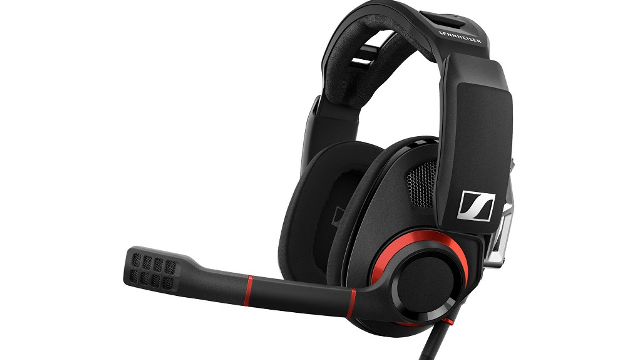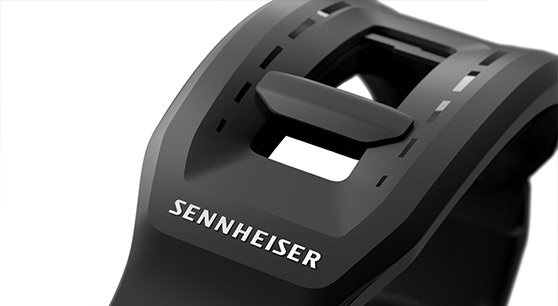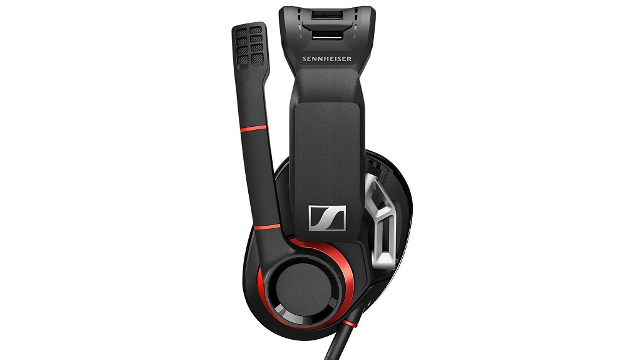I’ve reviewed quite a few headsets over my nearly two years at GameSkinny. From Corsair to HyperX and what seems like a countless lot in between, I’ve sampled a little bit of everything that corner of the peripherals market has to offer.
After a while, things start to sound if not the same, similar. It gets harder to pick out the minute differences in drivers or mark the true disparities between this software or that. But in all that time, this is the first I’ve gotten my hands on a Sennheiser — the grandpappy of all grandpappies.
I’d always heard that Sennheiser sound was some of the best audio quality you could get — if not the best. I’d always heard that no matter how much I liked my favorite headset right now, a Sennheiser would make me green with envy. And although I paraphrase that last part from the glut of conversations I’ve had with audiophiles over the years, there’s an inalienable truth to it.
It’s damn hard to go back to my other headsets after sampling Sennheiser’s GSP 500 gaming headset.

Design and Comfort
Out of the box, the GSP 500 feels like something engineered and manufactured by Germans. It’s sturdy. It’s durable. And it’s ergonomic.
One of the first things you’ll notice is that the headset doesn’t feel like it’s going to break in your hands. Although it’s mostly made of plastic, that plastic is both relatively lightweight and resilient — the headset weighs around 358 grams. That’s eight grams more than the arguably flimsy-feeling Logitech G533 but nearly 70 grams lighter than SteelSeries’ Arctis Pro+.
What that means to you is this (and I say this with the utmost respect for both of those fantastic headsets mentioned above): the GSP 500 feels neither economical nor heavy. It feels very well-made — and like something that’s going to last you a very, very long time.
On top of that, it also means the GSP 500 is super comfortable. If you’ve read any of my other headset reviews, you know I’ve said more than once I think SteelSeries’ ski-band is one of the cushiest headbands on the planet. I love that headband more than I love a well-made spicy taco. But man, is the GSP’s headband its blow-for-blow rival.
The showcase here isn’t exactly what the headband is made of but instead the ability to customize the headband’s contact pressure. Open along the top, the headband features two sliders that can be placed together in the middle for centralized pressure, at opposite ends from each other, or anywhere in between. This means that if you’ve got a weirdly shaped dome like me, you can find a sweet spot that just right for you.

Moving down the headset, we come to the ergonomic earcups. Made of a soft, breathable material, these earcups don’t sweat. That’s pretty standard these days when it comes to (most) headsets, but what isn’t so standard is the way these earcups are shaped: they mirror the shape of the human ear, providing a more natural, comfortable fit than your average round or square earcups.
Another thing that makes them comfortable is the metal hinges that attach the earcups to the headband. These tilt and turn to fit a variety of face types and help the earcups better conform to your cheekbones and upper jaw. And although it’s unfortunate the earcups don’t fully rotate and you can’t lay them flat on your collarbone when not in use like those found on the Logitech G Pro, for example, they’re so comfortable and flexible that I’ll give them a pass this time around.
What’s more, you’ll also find a dearth of controls on the GSP 500’s earcups. Typically, many newer headsets have a handful of volume and chat controls, as well as inputs, on one or both earcups. Here, you’ll find a simple volume wheel on the right earcup. I especially like that the volume control is elegantly integrated into the headset and doesn’t look like a volume knob. It’s contoured edges make it easy to pick out, even though I do think it’s a tad hard to turn.
Lastly, the noise canceling microphone on the GSP 500 works like a charm. Positioned on the left earcup just above the headset’s only I/O, the mic is flexible, but just barely. This is where the GSP 500 looks like a gaming headset; you can’t remove the microphone, just simply raise or lower it. That’s not to say such a design is a detriment to the headset, but it is something that might turn off some who want something more ubiquitous.

Performance
My biggest gripe about Sennheiser’s GSP 500 is that it’s just not very loud. And I admit: loud is relative. Some users will think the GSP 500 is plenty loud and read this part of my review with an incredulous glare. But for me, I don’t like having to turn a headset’s volume knob to maximum — while also turning my YouTube volume and system volume to maximum — to achieve skull-blasting 11.
However, after spending hours with headset, I think that volume “discrepancy” might just be because the headset is so damned good at recreating authentic sound via an open-acoustic design.
So, despite my curmudgeonly misgivings about the headset’s volume control, you’ll be hard-pressed to beat the sound on the GSP 500. As an arm-chair audiophile, I’m constantly blown away by what the GSP 500 can do. It lets me hear frequencies I never knew were there and rediscover movies, music, and games like few other headsets can.
Listening to songs from Northlane, While She Sleeps, and Tesseract, there were (are) guitar, bass, and drum sections I’d never heard before — now resoundingly clear. Toms thrummed out in thrilling sonic waves, bass undulated through synths, and harmonics pinged through trebles and mids without either losing strength or impeding other tones.
For classical overtures such as Beethoven’s Piano Sonata No. 3 in C Major, it felt as if I were in the concert hall, standing right next to the piano. And although the GSP 500 isn’t a surround sound headset out of the box, it’s stereo offerings are robust enough to mimic that functionality, especially when reproducing well-recorded sound.

In gaming, the GSP 500 gives new life to many of the games I’ve played for hours on end. It emphasizes Kratos’ guttural tones in God of War. It brightens the whisps of zipping bullets in Battlefield 1. And it makes the irritating simul-banter of Far Cry 5 less grating and actually distinguishable. Since the headset isn’t surround sound, you won’t get 100% accurate directional sound, but what you will find here isn’t too shabby.
If you do want to get 7.1 surround on the GSP 500, though, you can — all while keeping it in the Sennheiser family. The only real downside is that you’ll have to pick up an external DAC and drop another $250 to get it, which is a pricey proposition considering the headset itself already costs $250 by itself.
—
If you’re looking for something that immerses you in sound, the GSP 500 isn’t exactly it. Because of its open ear design, you’ll be able to hear a lot of the conversation and commotion around you. If you’re in a loud environment, that can be pretty distracting to some users — and in fact, this is the primary reason I’m giving it a 9 and not a 10.
However, the open ear technology affords crisper, more realistic tones and gives those that need it the ability to listen to music or play games without alienating those around them. If you want a closed-ear design, check out the GSP 600.
The GSP 500 comes with a two-year international warranty, and it works on PS4, PC, Mac, and mobile devices. It also works on Xbox One, but may require the Xbox One stereo headset adapter (we didn’t test it, but Sennheiser does suggest it).
At the end of the day, this headset is for the high-end gamer who also has audiophile tendencies. I don’t imagine your average gamer is going to opt for these, not only because of price, but also because those average gamers aren’t necessarily looking for the sound this headset provides.
In other words, the GSP 500 is one of the very best headsets you can buy but it’s also a luxury item. If you have the disposable income for it, there’s no question you should pick it up. If you want high-fidelity sound, there’s no question you should pick it up. But if you just want something to get you through the next CoD MP match, apply elsewhere — this headset will be lost on you.
You can buy the Sennheiser GSP 500 on Amazon for $229.95.
[Note: Sennheiser provided the headset used in this review.]






Published: Jun 28, 2018 01:33 pm